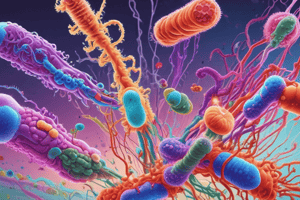Podcast
Questions and Answers
What distinguishes Klebsiella colonies on MacConkey agar?
What distinguishes Klebsiella colonies on MacConkey agar?
- Green colonies with black centers
- Glistening, mucoid character (correct)
- Pink colonies due to lactose fermentation
- Colorless colonies
Which agar is commonly used for the primary isolation of Salmonella?
Which agar is commonly used for the primary isolation of Salmonella?
- Hektoen Enteric Agar
- MacConkey Agar
- Blood Agar (correct)
- Eosin Methylene Blue (EMB) Agar
Which test is commonly used for the selective recovery of Salmonella from stool culture?
Which test is commonly used for the selective recovery of Salmonella from stool culture?
- Urease Test
- Salmonella-Shigella (SS) Agar (correct)
- Oxidase Test
- Triple Sugar Iron (TSI) Agar Test
What distinguishes Shigella colonies on SS agar?
What distinguishes Shigella colonies on SS agar?
Which member of the Enterobacteriaceae family shares the ability to swarm over the surface of media?
Which member of the Enterobacteriaceae family shares the ability to swarm over the surface of media?
Enterobacteriaceae is a large diverse family of bacteria commonly referred to as the ______ rods
Enterobacteriaceae is a large diverse family of bacteria commonly referred to as the ______ rods
Enterobacteriaceae bacteria are normal flora of the ______ tract of humans and animals
Enterobacteriaceae bacteria are normal flora of the ______ tract of humans and animals
Genus and species designations are based on ______ characteristics, such as patterns of carbohydrate fermentation
Genus and species designations are based on ______ characteristics, such as patterns of carbohydrate fermentation
The genera containing the species most virulent for humans( true pathogens) are: Escherichia, Shigella, Salmonella, Klebsiella, ______
The genera containing the species most virulent for humans( true pathogens) are: Escherichia, Shigella, Salmonella, Klebsiella, ______
If motile, Enterobacteriaceae bacteria possess a ______ arrangement of flagella
If motile, Enterobacteriaceae bacteria possess a ______ arrangement of flagella
Most strains of E coli ferment ______ rapidly
Most strains of E coli ferment ______ rapidly
Klebsiella colonies on MacConkey agar have a glistening, mucoid character due to the presence of a polysaccharide ______
Klebsiella colonies on MacConkey agar have a glistening, mucoid character due to the presence of a polysaccharide ______
Salmonella usually produce non-hemolytic smooth white colonies on ______ Agar
Salmonella usually produce non-hemolytic smooth white colonies on ______ Agar
Shigella do not ferment ______ or produce hydrogen sulfide gas
Shigella do not ferment ______ or produce hydrogen sulfide gas
Proteus mirabilis and Proteus vulgaris share the ability to swarm over the surface of ______, rather than remaining confined to discrete colonies
Proteus mirabilis and Proteus vulgaris share the ability to swarm over the surface of ______, rather than remaining confined to discrete colonies
Flashcards are hidden until you start studying
Study Notes
Enterobacteriaceae Overview
- Enterobacteriaceae is a large and diverse family of bacteria known as Gram-negative rods.
- These bacteria can ferment sugars, classifying them as fermentative.
- They are considered enteric bacilli, typically found as normal flora in the intestinal tracts of humans and animals.
Classification
- Classification is based on phenotypic characteristics, particularly patterns of carbohydrate fermentation.
- Major genera containing the most virulent species for humans include:
- Escherichia
- Shigella
- Salmonella
- Klebsiella
- Yersinia
- Additional medically important but less common genera are:
- Enterobacter
- Serratia
- Proteus
- Morganella
- Providencia
Common Characteristics
- Bacteria in the Enterobacteriaceae family are gram-negative rods.
- If motile, they typically have a peritrichous arrangement of flagella; exceptions include non-motile Shigella and Klebsiella.
- They are facultative anaerobes, capable of surviving in both aerobic and anaerobic environments.
- Enterobacteriaceae are oxidase negative.
- All species ferment glucose, although they exhibit significant variability in other biochemical characteristics.
Studying That Suits You
Use AI to generate personalized quizzes and flashcards to suit your learning preferences.




